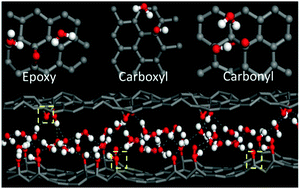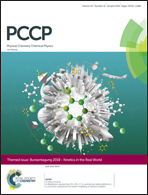A reactive molecular dynamics study of graphene oxide sheets in different saturated states: structure, reactivity and mechanical properties†
Abstract
For GO related nanocomposite design, it is of great importance to understand the behavior of water molecules ultra-confined in the interlayer region of graphene oxide (GO) sheets. In this research, to gain molecular insights into the influence of water on the properties of GO sheets, reactive force field molecular dynamics was employed to model a GO sheet with a water content of 1.3 wt%, 11.5 wt%, 18 wt% and 23.5 wt%. The epoxy and hydroxyl groups in the GO sheet exhibit high reactivity: the proton transferred from hydroxyl to dissociated epoxy contributes to carbonyl formation, which enhances the polarity of the GO sheet and strengthens the H-bond network between the functional groups. The epoxy, hydroxyl and newly formed carbonyl groups contribute to the structural hydrogen bonding with high stability. With increasing water content, the interlayer structural H-bonds between functional groups are gradually substituted by those contributed by water molecules, which weakens the interlayer stiffness and cohesive strength for GO sheets. Furthermore, the reactive force field allows coupling between the mechanical response and chemical reactions during uniaxial tensile deformation in the intra-layer direction. On the one hand, the relative epoxy bond is stretched until it is broken and transformed into a carbonyl group to resist tensile loading. On the other hand, interlayer water molecules, attacking the deformed GO sheets, are dissociated into carboxyl groups in the broken region.



 Please wait while we load your content...
Please wait while we load your content...